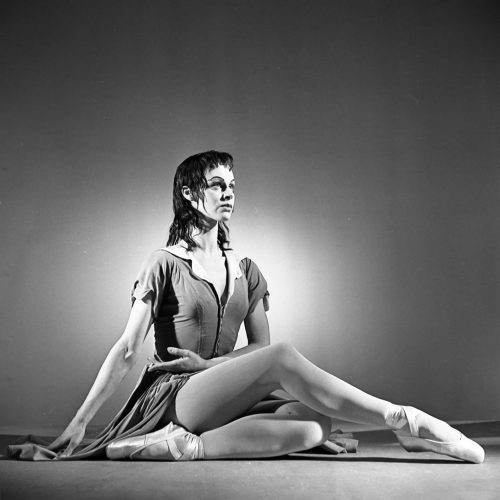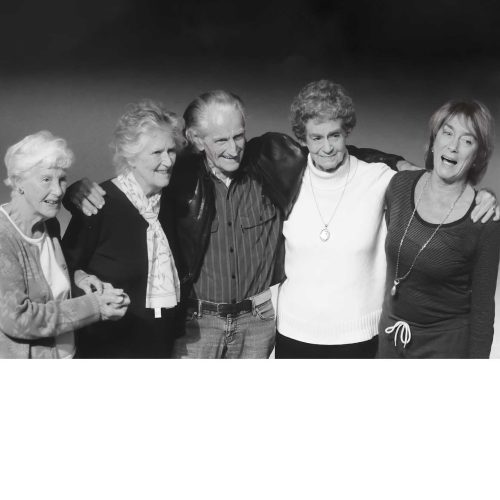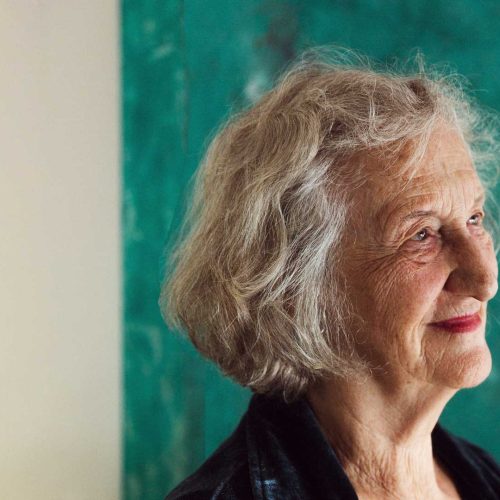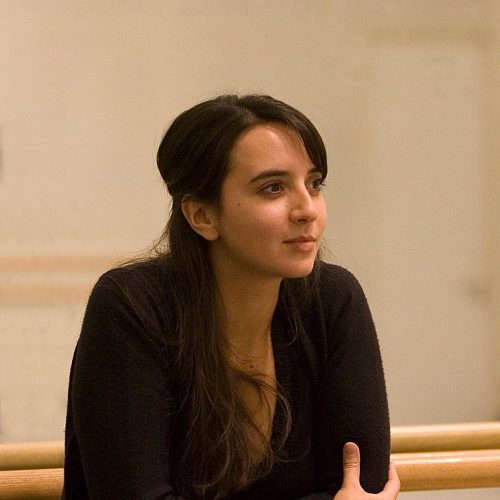Julia Farron
Julia Farron was born in London in 1922. She was part of the vanguard of extraordinary talent that helped shape ballet in 20th Century Britain. In 1931 she was the first scholarship pupil to join the Vic-Wells Ballet School and two years later she joined the Vic-Wells Ballet, as its youngest member. Vibrant and consummately theatrical, her conversation, like her dancing, is always a mix of wit and wisdom. In conversation with Bruce Sansom, she throws light on the early years of Sadler’s Wells Ballet, with all its attendant conventions and eccentricities. She later became a superb character artist as well as teacher.
First published: August 12, 2025
Biography
Born in London in 1922, Julia Farron first studied dancing at the Cone School and in 1931 was the first scholarship pupil to join the Vic-Wells Ballet School. Her stage debut was in pantomime at Drury Lane in 1934 and two years later she joined the Vic-Wells Ballet, as its youngest member.
Over the next 30 years her fine talent, intelligence and theatrical power helped lay the foundations for the sort of company Ninette de Valois was attempting to forge. From ‘the classics’ as staged by Nicholas Sergeyev, at the start of her career, which she was on the spot to absorb, through to her final role in 1965, as Lady Capulet in Kenneth MacMillan’s Romeo and Juliet, Julia Farron danced and created roles for many of the great choreographers of the 20th Century. From the works of de Valois herself, to Frederick Ashton, Kenneth MacMillan, John Cranko, Léonide Massine and Georges Balanchine, her range was legendary, and thankfully for the generations of students to follow, so were her powers of recall, both practical and theatrical.
Her Lady Capulet – a masterpiece of theatrical expertise – was a wonderful culmination to Farron’s career and a fitting tribute from MacMillan to a pioneer of British ballet. Her stage career was followed by a teaching position at The Royal Ballet School from 1964 until 1982, when she was appointed Assistant Director of the Royal Academy of Dance. In 1983 she became Director and retired in 1989 as an Honorary Fellow. In 1994 the Royal Academy of Dance awarded her the Queen Elizabeth II Coronation Award.
In her later years Julia Farron was a keen supporter of The Royal Ballet School’s White Lodge Museum and Resource Centre. In 2012 she was appointed OBE for services to dance.
Transcript
In conversation with Bruce Sansom
Julia Farron: What happened was Madam decided…she had a school, but she hadn’t any young dancers at that time, she hadn’t really got to the point where she had got people who could do…the children, for instance, in Nutcracker…and that’s what she wanted, she wanted Clara, and Franz [Fritz], and the children. Because the school she had were older kids, you know, they weren’t young, there wasn’t a junior school. So she didn’t have these kids…so what she did, was she went to all the…schools of ballet, of which there were quite a few and she said, ‘I will give a scholarship to one of your girls, if you will pay for another girl to have a scholarship,’ There was an audition, and we did a class, and then we had to do a couple of dances…I think a sort of…what they called in those days, demi-character which meant it had to have some sort of story, and a classical dance…and it was all done on the stage. I didn’t get the main scholarship from my school, I got the second one, the one which the school had to pay for…the girl that got the main scholarship, she had a better technique than me I remember…but she didn’t last [laughing], she was out in no time at all, and I was the one that stayed. So that was entirely…to get us ready to go on at Christmas time.
Bruce Sansom: So what time of year was this? Are you still at school at this point as well?
Julia Farron: Uh huh. I am twelve.
The scholarship started in about April, went through, and we did Nursery Suite, and then into The Nutcracker…and then we went on until April, and we thought that was the end of that, but they said no, no, they would give us another year, but they had also got another group in by that time, so we got a bit bigger. If I work it backwards … I went into the Company on my fourteenth birthday, because I couldn’t leave school until I was fourteen…fourteen, you could legally leave school at fourteen.
Bruce Sansom: So as a scholar, how many classes were you…
Julia Farron: We had two classes a week, we used to go Tuesdays and Fridays.
Bruce Sansom: In the evenings?
Julia Farron: After school
Bruce Sansom: How many scholars were there?
Julia Farron: I think it was about twelve. I think there was…six schools I think took part, and they took two from each school.
Bruce Sansom: Did any of them continue?
Julia Farron: No. No. Nobody did…and then the second time, the second year, when they had another group, and then several of them came in, Moyra Fraser was one who came the second time, and a girl called June Vincent, who wasn’t there very long, but…did go into the Company throughout the War…she was there.
Bruce Sansom: It was a scholarship, so your tuition was paid…but you weren’t receiving any payment, even for the performances?
Julia Farron: No, no. Absolutely not, no.
Bruce Sansom: So these performances, where did they take place?
Julia Farron: At the Wells [Sadler’s Wells].
Bruce Sansom: And what do you remember of Nursery Suite?
Julia Farron: I remember my first step of my solo. I was sitting on the floor with my back to the audience, and I was sad because I had lost my sheep. I had a lovely costume, it was designed by Billy Chappell – William Chappell – and it was a beautiful pink…a long dress, a long sort of Sylphide length…pink on the outside, and white underneath…pretty, very pretty. And Madam did one of her Madam things, the first time I ever saw it…she said, ‘It’s ridiculous! Shorten that skirt!’ [both laugh] …and he went…[she sighs] and he brought his shears and went [she indicates cutting] and took out four inches, and she said, ‘Shorten that skirt!’ She went on, shortening that skirt! [Laughing]. And there’s a picture somewhere I think I have got, and it’s a tutu! [Both laugh].
Bruce Sansom: So, you have done Nursery Suite, you have been Bo-Peep, were you anything else in it, or was that…?
Julia Farron: No, it was just a solo.
Bruce Sansom: Right.
Julia Farron: There was no sort of corps de ballet, no working together at all…a series of dances.
Bruce Sansom: And then there was Casse Noisette
Julia Farron: And then there was Casse… Nutcracker. It was the first time I had ever seen a Company, a group – I had never seen men dancing. I had a lovely thing at the dress rehearsal…I had always rehearsed in my little soft shoes, with elastics over, and when it came to it, Madam said you must wear proper ballet shoe, so, proper ballet shoes were got for you, with the ribbons, and I had a lesson from Jill Gregory I think, about how to knot the shoe [ribbon]s and how to tuck them in from the top down. In the scene with the Rat King, I had to throw my shoe to divert the Rat King, so that the Nutcracker Prince could stab it…and at the dress rehearsal I couldn’t get my shoe off, so I rushed up and hit it. [Laughing]. I just went on his back and hit him and rushed away again!
Bruce Sansom: So you say…you first experiences as Clara, this is the first time you were seeing…
Julia Farron: The Company.
Bruce Sansom: The Company, with men in it.
Julia Farron: Yes.
Bruce Sansom: So you hadn’t seen them before?
Julia Farron: No.
Bruce Sansom: Did you subsequently?
Julia Farron: Yes.
Bruce Sansom: Or were you now sort of into the Company and that was…
Julia Farron: No, no, my mother, too, used to take me out, and we used to go up in the Gallery and watch, I was…I remember going up in the Gallery and watching the first night of [Les] Patineurs, which was after – I think it was after I had joined – which was fantastic, I had never heard an audience applaud like that, and…it was…I can still feel it, sitting up in the Gallery…marvellous…marvellous.
Bruce Sansom: So who were the sort of…the guiding lights. You have mentioned Jill Gregory joining it, and then Madam.
Julia Farron: Madam, yes.
Bruce Sansom: And Fred [Frederock Ashton] was around?
Julia Farron: Fred was around, Bobby [Robert Helpmann] of course.
Bruce Sansom: And what do you remember of them?
Julia Farron: I remember just being transfixed by watching…sitting on the floor, watching rehearsals, I used to just sit there. They occasionally used to say, ‘Don’t you think you ought to go home?’ [Laughing] ‘Otherwise your mother will be phoning us up.’
Bruce Sansom: You were travelling up and down on your own by now.
Julia Farron: Yes. Quite a long journey too. You see, there were all sorts of things when I think about it, it was…no money, I mean thirty shillings a week was what I got for the first…I think it was a couple of years, until I went onto proper corps de ballet rate, I actually got really what was just like a student.
Bruce Sansom: So this was once you had joined at fourteen?
Julia Farron: Yes.
Bruce Sansom: So what did you join as then, if you weren’t corps de ballet?
Julia Farron: I was corps de ballet.
Bruce Sansom: But you were on this cheap rate, thirty shillings.
Julia Farron: Well I suppose they reckoned at fourteen I wasn’t worth any more.
Bruce Sansom: So…what was the day like, once you had joined at fourteen…
Julia Farron: That was yes, well it started at the usual sort of ten o’clock class
Bruce Sansom: Who would teach?
Julia Farron: Oh, quite a lot of people. We used to have more guest teachers than you would imagine, because later on we didn’t, because of the War, when we had…who was around, you know. But we had Prisina, a marvellous woman called Prisina. She was tough as old boots, real tough. We used to have Margaret Craske, who was the Cecchetti teacher of the day, and we had [Nicholas] Sergeyev if he was there, once he had got there to do the Beauty [The Sleeping Beauty, which was titled The Sleeping Princess in 1939]. He used to take class…with a stick, which he used to hit us with. He was tough. My God, they were all tough actually.
Bruce Sansom: And when you say hit?
Julia Farron: Hit. [Laughing].
Bruce Sansom: Do you mean he would strike you, you know, turn that leg out, whack sort of thing?
Julia Farron: Yes, I mean hit! Yes, it was a little cane, actually, but like canes, it hurt. You came out covered in bruises….he was…I didn’t like him.
Bruce Sansom: How many [were] in the Company? How many people could he be hitting at any one time?
Julia Farron: He could be hitting…there were twenty-one girls, and as many boys as could be dragged off the streets, I think! I suppose there were about ten boys…we had enough on tour, the girls, to do [Les] Sylphides, exactly…so there was no understudy. So you couldn’t be off…
Bruce Sansom: And if…so if anyone ever was off, would they cancel that ballet, or would they just re-jig it?
Julia Farron:I think they would re-jig it, I don’t remember it actually happening…that there were…you would see Madam, occasionally, I think…I remember Margot being off, and Madam came on to do the Patineurs Pas de Deux, and she hadn’t danced for ages.
Bruce Sansom: I have not heard that before, my goodness.
Julia Farron: Mmm. She did, she went on, and really…almost at the last minute, it was a desperate situation, you know, and she did.
Bruce Sansom: So, joining at fourteen, you were out on tour then?
Julia Farron: Mmm.
Bruce Sansom: Where would the tours go?
Julia Farron: At that time, we used to do two touring sessions in a year. We used to do Oxford, Cambridge and Bournemouth in the spring, so that was about…and then we would be on holiday, and then in the August, September, we would go on a tour of the northern cities, we would go to Manchester, Birmingham, Newcastle, Glasgow, usually, I think.
Bruce Sansom: And in between you performed at Sadler’s Wells?
Julia Farron: Nothing. There was a gap in the summer where we didn’t get paid, at all. Some of the older dancers I think used to go and get jobs, but there was…between April and August I think it was, there was no pay, it was tough. And then of, course, when the War came, that gap disappeared, because we worked most of the year.
The first three week tour, which was the Oxford, Cambridge, Bournemouth, was at the end of the year’s work, that sort of finished the year. Then there was this break. And then we came back for rehearsals. I don’t know many weeks we had of rehearsals, I have forgotten that bit, possibly about two, I don’t think it would have been more…where they paid us half pay, fifteen shillings! [Laughing]. And then we went out on tour, and then when we came back from that tour, it was the beginning of the Sadler’s Wells season, which then went from, I suppose September probably, through till April again. We only worked two days a week.
Bruce Sansom: This is perform, you mean…
Julia Farron: Yes, yes. At the Wells. Tuesday nights, Friday nights, one week and Tuesday night, Saturday matinée the next week. So it was…and the rest was opera.
Bruce Sansom: So what was some of the rest of the repertoire?
Julia Farron: The first ballet that I was in, that was a created ballet, was Madam’s Prometheus; Fred did [A] Wedding Bouquet.
Bruce Sansom: Talk a little bit about Prometheus, and what you…
Julia Farron: I don’t remember a lot about it, it wasn’t a very good ballet, I think… [laughing].
Bruce Sansom: What was Madam like as a choreographer, in terms of being in the studio?
Julia Farron: Oh she was extraordinary. The thing that I remember most, because the first thing I did was Prometheus, and then the second thing I think with her, was Checkmate. And do you, she came…I can remember it absolutely clearly, we grouped…we gather together in the rehearsal room, eight of us, pawns…red pawns. She arrived late, papers all over the place, and she went to the piano, and Hilda Gaunt, I suppose it was – I can’t remember, it may not have been, it might have been another pianist – played the music, and she taught us the steps, and we discovered afterwards she had done it in the train, coming up from Waterloo. She had got it all written down, the whole thing was written down. We learned that dance so fast, it must have been a couple of hours and we had learned the whole dance, and she threatened us if we forgot it. She was absolutely adamant about everything about it… there was no if’s or buts, or maybe we will do it facing the other way or something, this was it!
Bruce Sansom: No experimentation, no, ‘Does this look good’…
Julia Farron: Absolutely nothing, I mean so unlike Fred, it was…because that was the other choreographer I knew, who was completely and utterly the opposite way as you well know.
Bruce Sansom: So what was the first Fred ballet that you worked on then?
Julia Farron: Oh…[A] Wedding Bouquet.
Bruce Sansom: Right, and this was a new creation?
Julia Farron: New, brand new…mad, dotty.
Bruce Sansom: So Madam turned up with paperwork, what did Fred do?
Julia Farron: He turned up and scratched his nose! [Both Laugh]. I mean, even then you realised how much he was inspired by what people in front of him did. He knew in his head what he wanted, but he had to see people doing it to work it, you know? And it was a pleasure – I mean it was the most pleasure I think I have had.
Bruce Sansom: I mean…
Julia Farron: Well, I didn’t know anything about…who is the dotty lady, that Gertrude Stein…I knew nothing about Gertrude Stein and her friend, Alice Toklas , and they turned up with this little dog, which was me. And that’s why the dog was in it. Because they wanted their little dog to be on the stage. They said they didn’t think I was small enough, but I was smaller than everybody else! [Laughing]. They said we haven’t got one smaller thank you very much! At one point, I had to as the dog, wear a little tutu…and this great big mask, and I was with Leslie and…Leslie Edwards and Michael Somes…and they were nice, strong, you know, nineteen, twenty, twenty one year old chaps, and I was this little thing, and they found it easy to chuck me about. And they did…and I can remember once being chucked a bit too far and dropped a bit too far in a fish dive, and the mask got completely squashed! [Laughing].
Bruce Sansom: And with you inside!
Julia Farron: Yes, with me inside!
Bruce Sansom: Was this in rehearsal or in performance?
Julia Farron: No, it was in performance! Michael got a bit carried away! [Laughing].
The transcript of this podcast may have been lightly edited for ease of reading.





